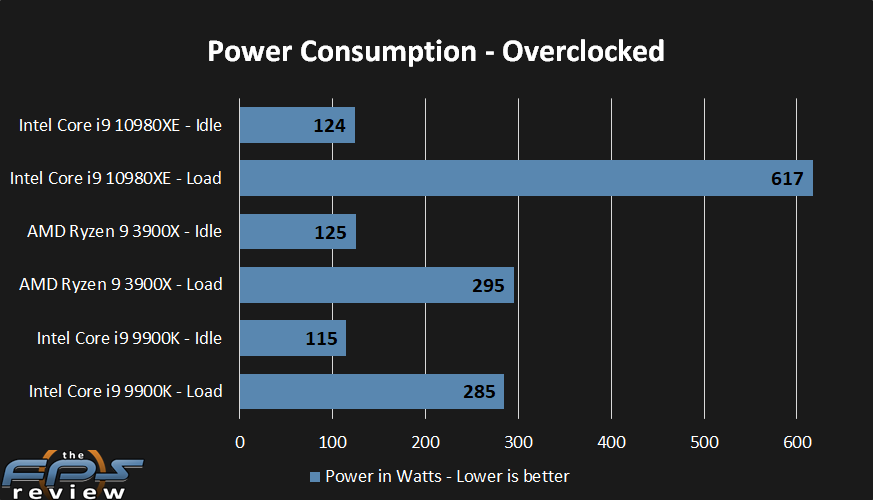Power Consumption
Our power consumption methodology is quick and dirty. It involves using a Kill-A-Watt device with only the test machine connected to it sans monitor and any external devices. The idle power is tested at the Windows desktop on a clean system while doing nothing but running background tasks. Load testing is done by using Cinebench R20 in a multi-threaded test. The power is then observed on the Kill-A-Watt instrument. These devices are not known for being super accurate, so this is a ballpark measurement. Cinebench R20 is largely used because it doesn’t utilize the GPU, which keeps the impact of the component to a minimum. All the systems we’ve tested from day one have been tested in this manner.
Like its predecessors, the Core i9 10980XE carries a 165w TDP. TDP is only applicable when the CPU is at its base clocks. When you start overclocking or even when Turbo Boost 2.0 or Max Turbo 3.0 kick in, the TDP usually gets left in the rearview mirror.

I’ve trimmed the graph down as many of the lower end CPU’s aren’t the type of thing you cross-shop when looking at an HEDT part like the 10980XE. As you can see, at idle its strangely efficient. I will concede that motherboard differences between the MSI MEG X570 GODLIKE and ASUS Prime X299 Deluxe II may account for the closeness between AMD’s 3900X and the Core i9 10980XE being similar at idle. I think the 3900X is probably more efficient and the AM4 motherboard in question is a far cry from that.
At load, under stock conditions, the power consumed by the 18c/36t CPU seems high but really isn’t that bad given that it has twice the cores and threads of the 9900K. Due to careful binning and slightly lower clocks, we see a part that has twice as many cores and threads, but nowhere near twice the power consumption. Intel’s fallen behind by being stuck at 14nm, but its managed to do a lot with it.
Power Overclocked

The results speak for themselves. At idle, the Core i9 10980XE doesn’t use much more power. However, under load, its inefficient nature rears its ugly head in a big way. Here it pulls well more than double what the 9900K system does at 5.0GHz (all core). We are running at 4.7GHz on all cores with this 10980XE with 1.25v. If you add an RTX 2080 Ti, custom water cooling loop, and anything else to the system, you’re probably going to want to go with more than a 1,000-watt power supply.
This also tells us precisely why the Core i9 10980XE’s clocks are so conservative. Being clocked to 4.7GHz here proves that there is more physical headroom for the new CPU to clock higher than its predecessors generally do. I’ll talk about overclocking in more depth later, but you get the idea. When you start raising the clocks on these things they pull more power and generate more heat than most people are prepared to deal with. Thus, Intel keeps the clocks conservative to maintain that 165w TDP.
